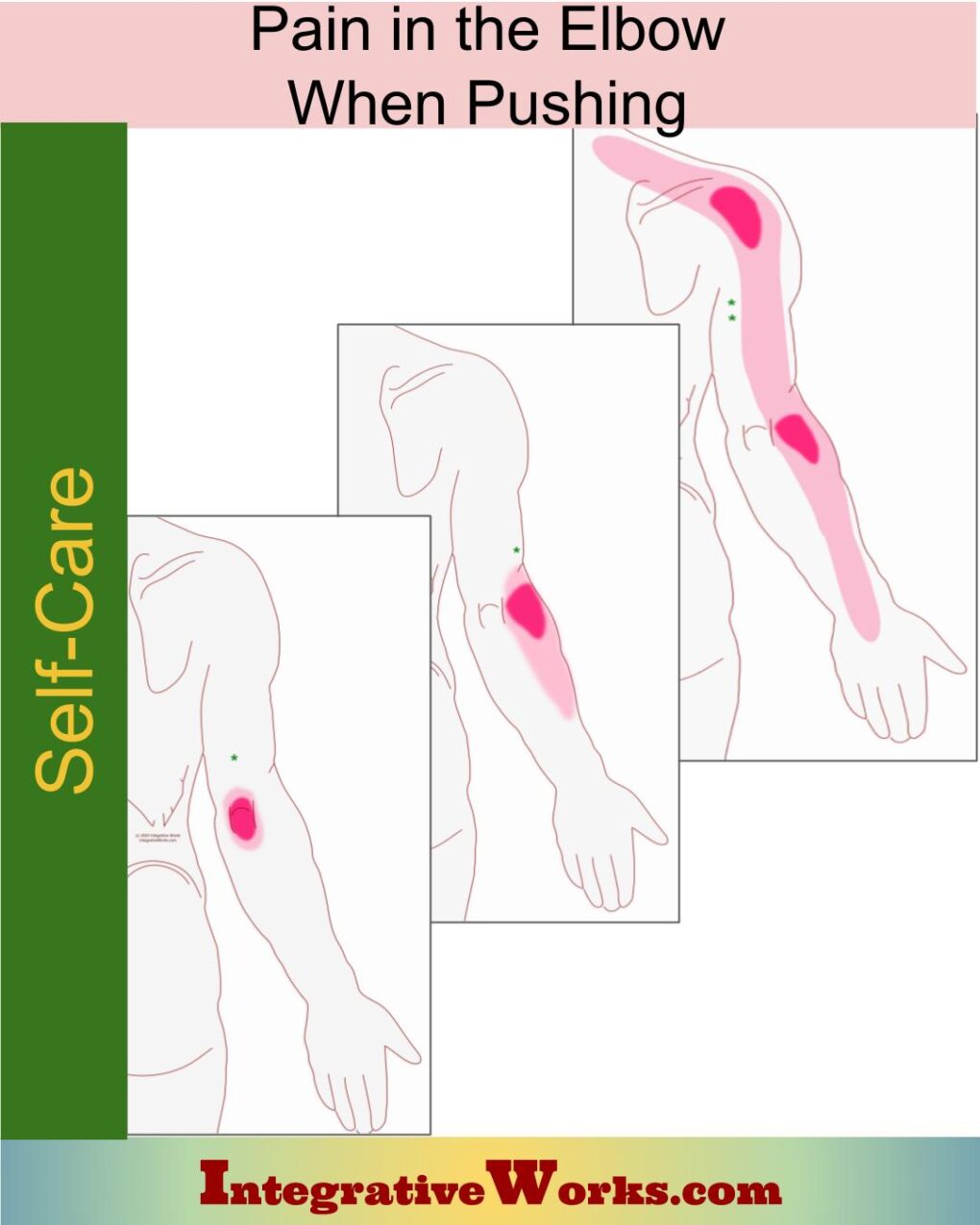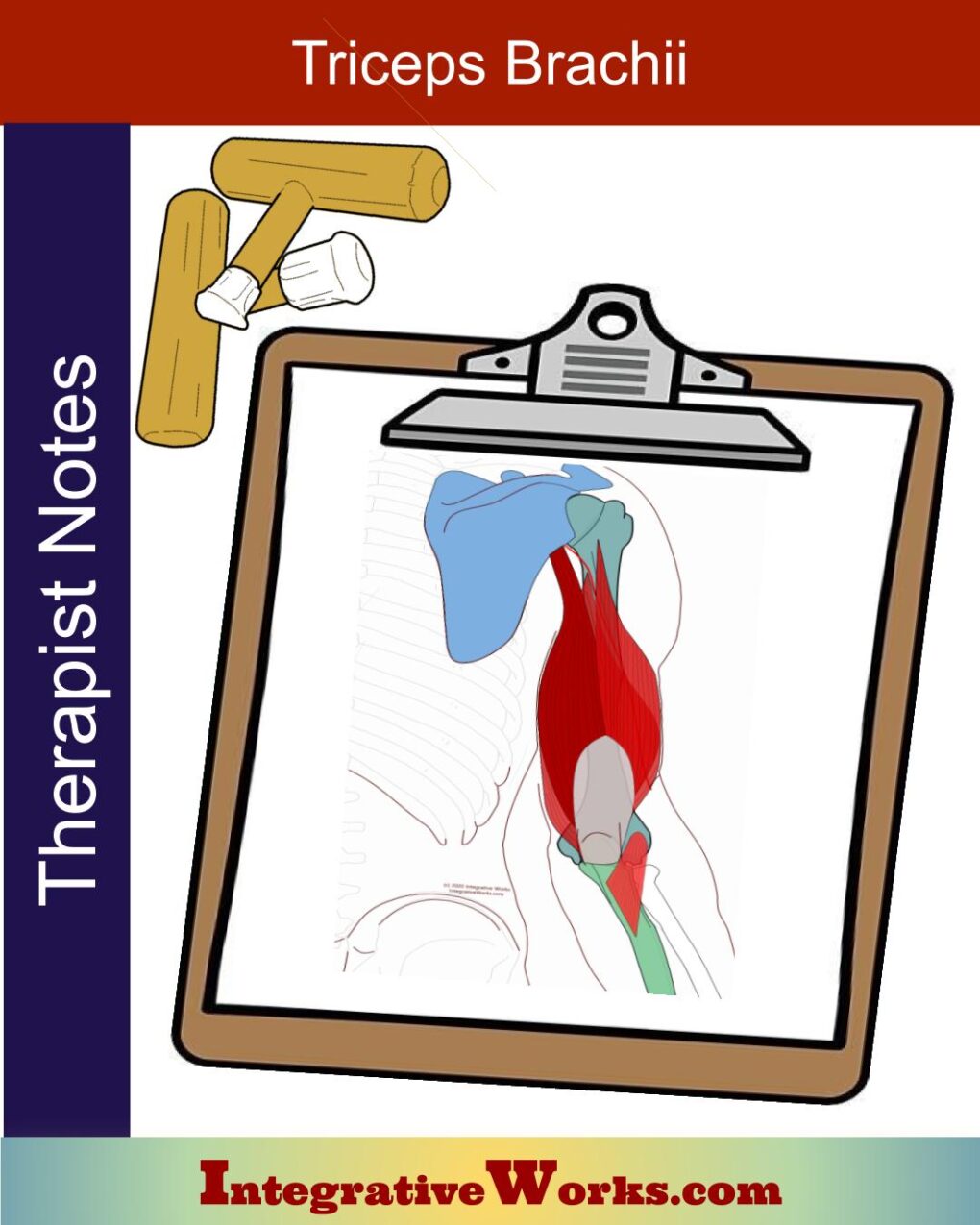Table of Contents
- How People Describe This Pain Pattern
- How You Activate and Intensify This Pain Pattern
- Self-Care – Getting Relief on Your Own
- Musculoskeletal Anatomy Behind Your Pain
- Therapy Notes for Massage and Bodywork
How People Describe This Pain Pattern
The trigger point referral patterns discussed here all create pain in the elbow from trigger points in the triceps muscle. Mostly, this pain occurs when you forcefully straighten the elbow. When they are chronic, they hurt all the time.
Many patients complain of “tennis elbow.” Therapeutically, it is called “lateral epicondylitis” and can come from trigger point referral of several different muscles. Usually, it comes from the supinator muscle and hurts during a twisting flick of the wrist. Each of these “tennis elbow” patterns is a little different.
People who don’t play tennis complain of other activities that straighten the elbow under resistance. Weight lifting, gardening, pressing out cookies, and bracing yourself on amusement rides are classic irritants.
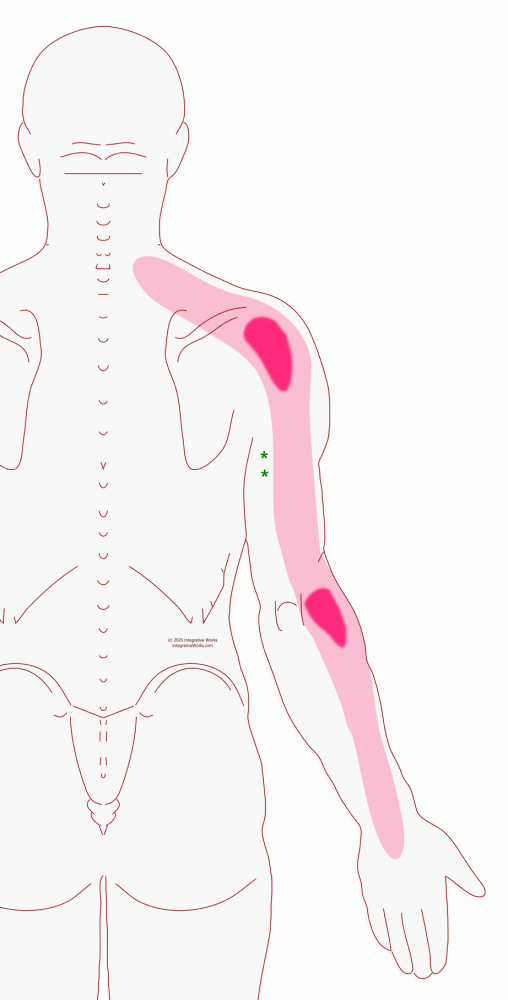
Elbow Pain While Moving the Arm Back
This is one of the most common patterns of elbow pain. It produces pain that hurts at the elbow and creates vague pain up the back of the arm. This head of the triceps crosses the shoulder and elbow joint. So, it bothers people in activities that forcefully extend the elbow while drawing the arm back or down. This one is different from the other two because there is often vague pain along the back of the arm.
Sometimes, This trigger point hurts primarily at the shoulder. This is because those motions tend to happen when the shoulder is stretched overhead, like serving a tennis ball. I discuss that in this other post.
How You Activate and Intensify This Pain Pattern
In tennis, this often hurts in a reaching backhand with a backspin. It can also be aggravated on service when the elbow snaps straight.
Patients who don’t play tennis aggravate these trigger points in other ways. Whipping the hose behind you while working in the yard irritates it. It bothers some people when tugging the covers while making the bed. Again, this involves straightening the elbow while moving the arm down or back.
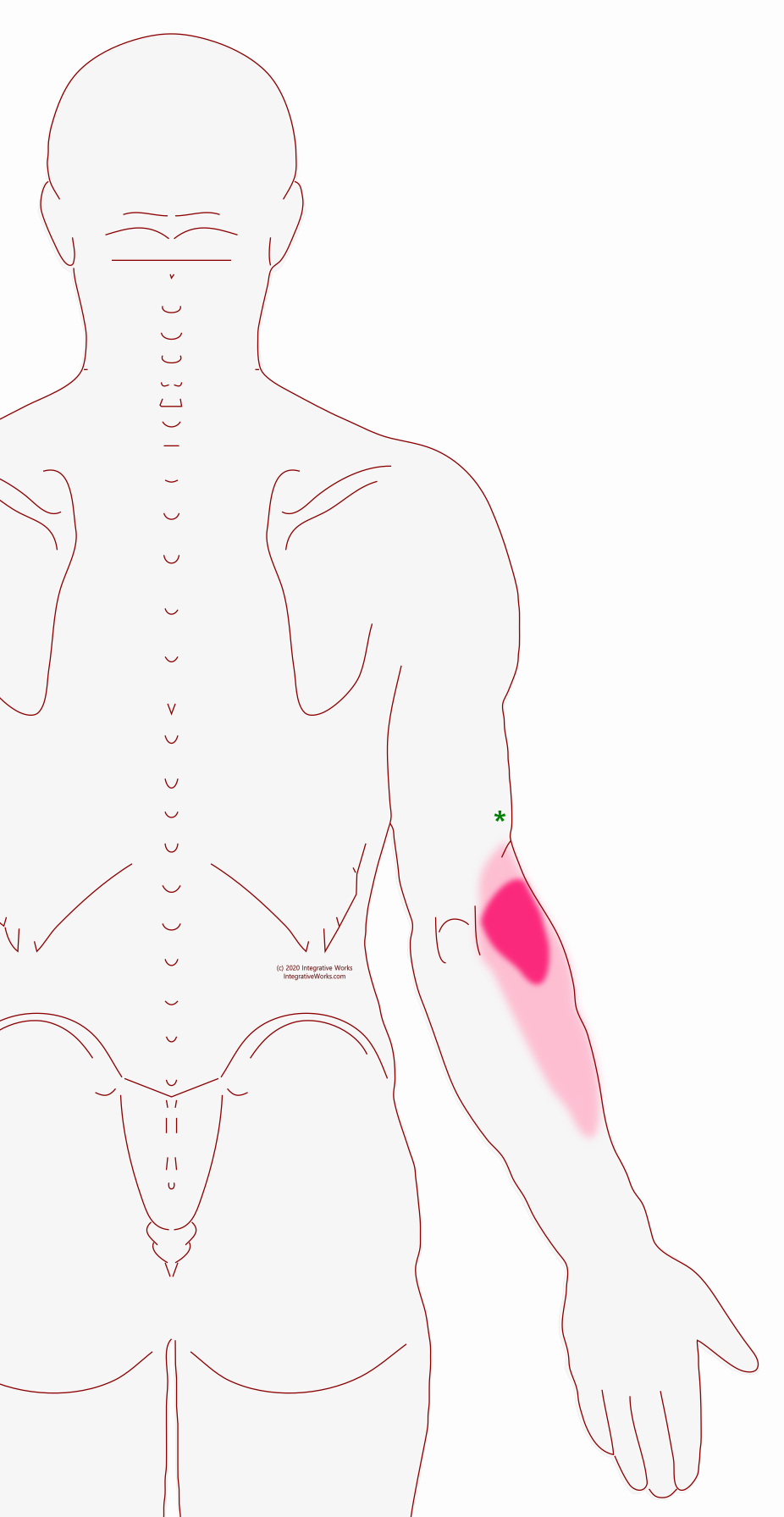
Chronic Pain Extends Toward Thumb
This trigger point creates pain in pushing motions that straighten the elbow, like serving or a reaching backstroke. For players, it still seems to be “tennis elbow.” Other people create this pain with unusually vigorous activity in the yard or the house or on a physically challenging weekend outing.
When this is chronic, the outside of the elbow aches constantly. Often, it creates a trail of pain toward the thumb.
How You Activate and Intensify This Pain Pattern
Unlike the previous trigger point, the shoulder and upper arm movements are less critical. This muscle is the meaty prime mover of the elbow. It secures the ulna instead of crossing over to the shoulder blade.
People activate this with repetitive, forceful, or jerky activities like digging in the yard. Also, weightlifting bench presses, shoulder presses, chopping nuts, and cutting cookies aggravate this muscle. Sometimes, forceful throwing does it too.
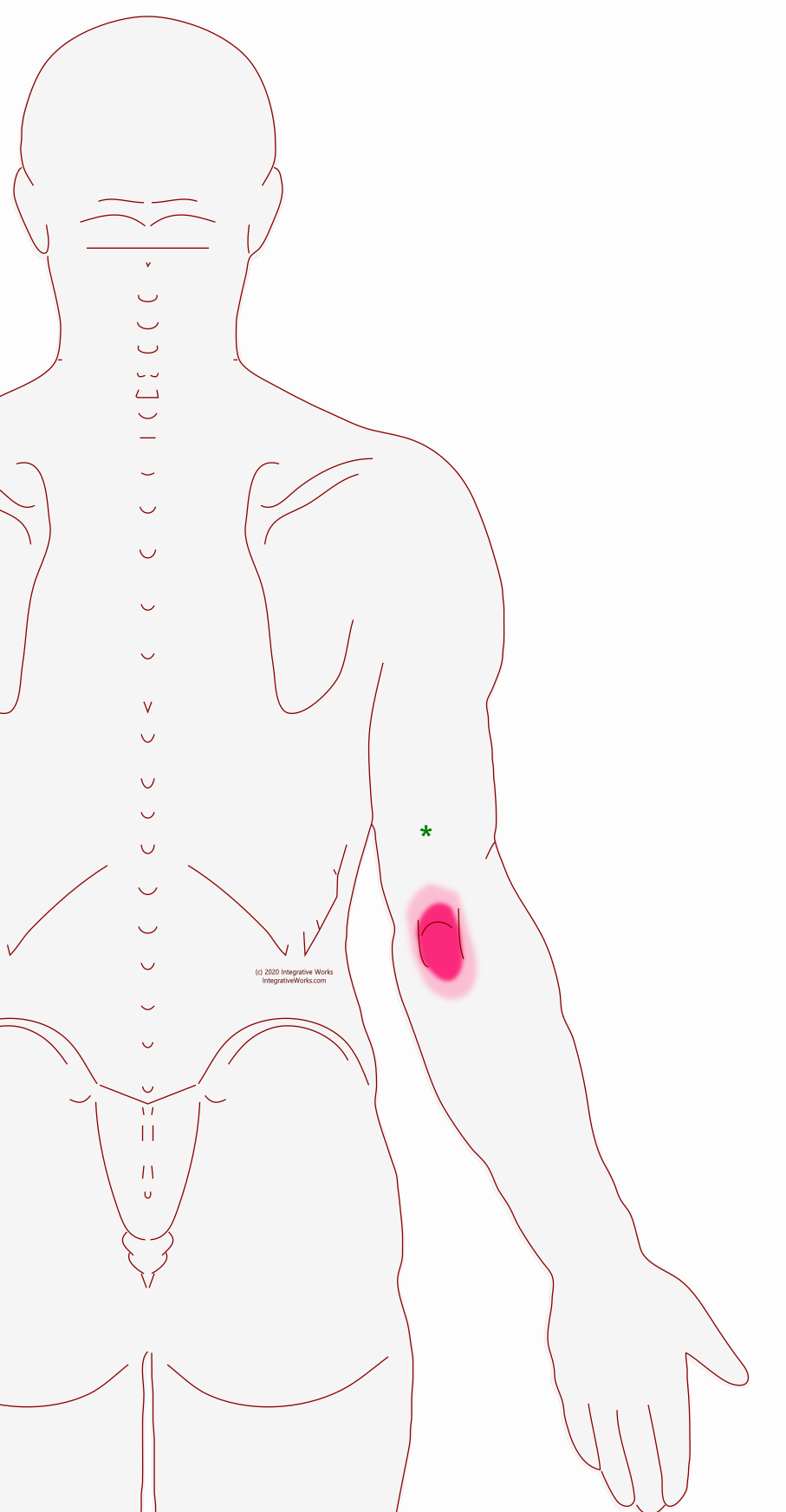
Feels Bruised
Sometimes, patients complain of pain right on the hard prominence of the elbow. Anatomically this is called the olecranon process. Patients are often concerned that they have bruised or strained the attachments on the elbow. They also express concerns about bumping the elbow or damaging the joint, and they don’t know how they did it.
How You Activate and Intensify This Pain Pattern
This is a different trigger point in the same medial head of the triceps. It also hurts under a forceful extension of the elbow in the same sort of activities. On this one, like the previous trigger point, stabilizing the shoulder or extending the arm is not as important.
Take a look at the activities in the previous section. The same activities of repetitive, forceful, or jerky extension of the elbow aggravate this too. Digging. Chopping. Throwing. Dumbell Presses.
The Musculoskeletal Anatomy Behind Your Pain
Musculoskeletal Anatomy
This post on anatomy contains standard information about the origin, insertion, function, and innervation of muscles. Additionally, it includes information on functional considerations and anomalies.
Find Related Posts
Anatomy posts have a grid of all related posts. This includes posts on pain patterns, self-care, therapy notes, NMT protocols, cranial techniques, and cases.
Getting Relief on Your Own
Clinically Proven
Self-Care Strategies
Self-Care Posts have common sections to make them easy to follow and understand:
- Activities to Avoid or Change
- Strategies for Quick Relief
- Stretches and Exercise for Longer-Lasting Relief
- Yoga Corner
Therapy Notes for Massage and Bodywork
Better Bodywork
Through Shared Expertise
Therapy Notes provide details for cranial, spinal, and local joint work. These notes also link to a traditional neuromuscular protocol.
By treating integrative components first, direct work on the muscle becomes less intense while providing longer-lasting relief.
Support Integrative Works to
stay independent
and produce great content.
You can subscribe to our community on Patreon. You will get links to free content and access to exclusive content not seen on this site. In addition, we will be posting anatomy illustrations, treatment notes, and sections from our manuals not found on this site. Thank you so much for being so supportive.
Cranio Cradle Cup
This mug has classic, colorful illustrations of the craniosacral system and vault hold #3. It makes a great gift and conversation piece.
Tony Preston has a practice in Atlanta, Georgia, where he sees clients. He has written materials and instructed classes since the mid-90s. This includes anatomy, trigger points, cranial, and neuromuscular.
Question? Comment? Typo?
integrativeworks@gmail.com
Follow us on Instagram

*This site is undergoing significant changes. We are reformatting and expanding the posts to make them easier to read. The result will also be more accessible and include more patterns with better self-care. Meanwhile, there may be formatting, content presentation, and readability inconsistencies. Until we get older posts updated, please excuse our mess.


